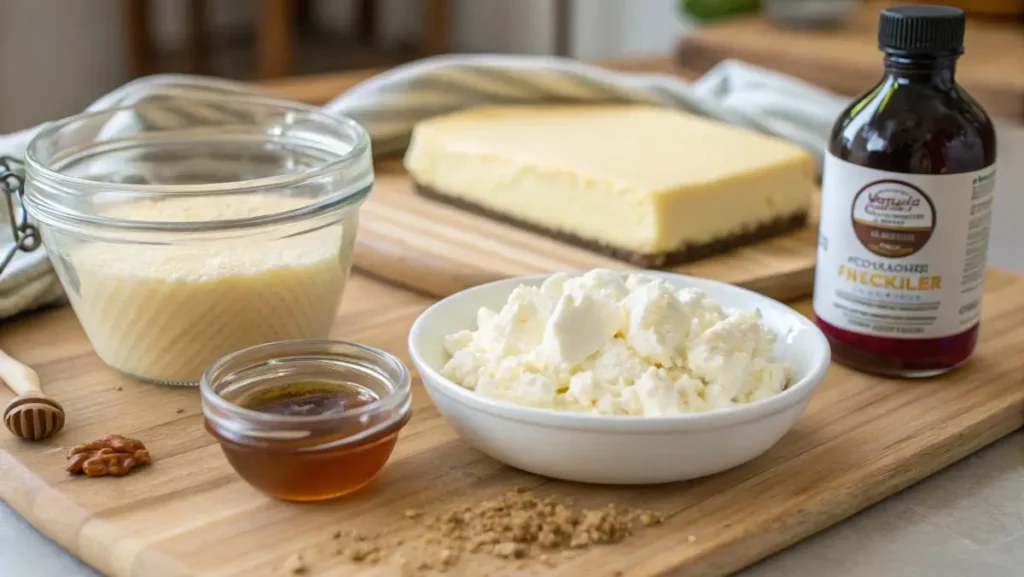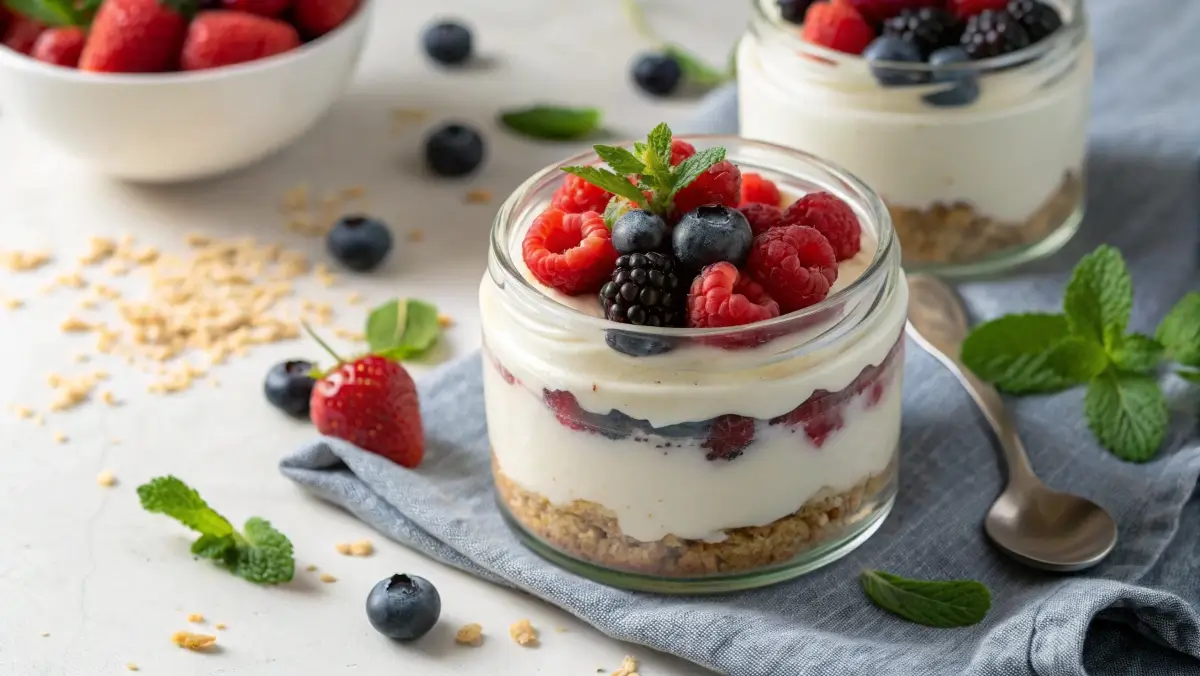GAPS Cream Cheese Dessert Recipe: Delicious Gut-Healing Sweets You’ll Crave
Dessert can be part of a healing diet—yes, even one like GAPS. For those following the Gut and Psychology Syndrome (GAPS) protocol, finding satisfying, compliant treats is often a challenge. But cream cheese, when properly prepared, opens the door to rich, creamy, gut-healing options that don’t sacrifice taste.
In this guide, you’ll discover how to create a delicious GAPS cream cheese dessert recipe that’s easy to prep, family-friendly, and totally aligned with the principles of the GAPS diet. We’ll cover essential ingredients, flavor boosts, storage hacks, and even kid-friendly variations. Learn more about cottage cheese desserts for more creamy inspiration. Let’s jump in.
Table of Contents
Understanding GAPS Diet Desserts with Cream Cheese
What is the GAPS diet and why dessert matters
The GAPS diet is a healing nutritional plan designed to repair the gut lining and rebalance the microbiome. It focuses on nutrient-dense foods like bone broth, fermented vegetables, and high-quality animal fats. But that doesn’t mean you have to skip dessert.
Desserts play a psychological and emotional role, offering comfort during a restrictive phase. They also provide a way to incorporate beneficial fats and enzymes—especially when made with cultured or homemade cream cheese.
How cream cheese fits into the GAPS protocol
Cream cheese is allowed on the GAPS diet, but with one major rule—it must be homemade or made from cultured, full-fat milk without additives. Store-bought varieties like Philadelphia cream cheese may contain gums or stabilizers unless you source the plain, organic kind.
Its soft texture and mild flavor make it ideal for desserts, especially those that don’t require flour or processed sugar.
Nutritional profile of cream cheese for gut healing
Cream cheese offers healthy fats that support brain function and hormone production. It’s also rich in fat-soluble vitamins like A and K2, which aid in tissue repair. When fermented, it contains probiotics that can support digestion and gut flora diversity.
Plus, its creamy texture allows for versatile recipes—from mousse and no-bake cheesecakes to GAPS-friendly dips.
Don’t miss our gluten and dairy free dessert ideas if you’re exploring multiple dietary preferences in your household.
Core Ingredients for GAPS Cream Cheese Desserts
Approved dairy products and substitutions
To stay GAPS-compliant, dairy must be homemade or fermented. Full-fat raw milk cream cheese is ideal. You can make it by straining homemade yogurt or kefir. If you can’t tolerate cow’s milk, goat’s milk cream cheese is a solid option.
Avoid anything with carrageenan, gums, or preservatives. For richer desserts, you can blend in ghee, homemade sour cream, or fermented heavy cream. These add texture and nutrient density without breaking GAPS rules.
If dairy’s off the table entirely, consider cultured coconut cream or cashew cheese—only if tolerated during later GAPS stages.
Natural sweeteners and their GAPS compliance
Refined sugar is a no-go. Instead, use raw honey—always in moderation. It’s the only sweetener allowed in GAPS because it’s monosaccharide-rich and doesn’t feed bad gut bacteria.
Some recipes may include dried fruits like dates or figs for sweetness, but they must be blended and used sparingly.
Avoid maple syrup, coconut sugar, or agave. These are not GAPS-approved and can cause flare-ups.
Here’s a quick table to keep you on track:
| Sweetener | GAPS Approved | Notes |
|---|---|---|
| Raw honey | ✅ Yes | Best used raw or lightly heated |
| Dates (blended) | ✅ Limited | Use sparingly |
| Coconut sugar | ❌ No | Disrupts gut healing |
| Stevia | ❌ No | Can irritate gut lining |
Flavor enhancers: spices, extracts, and textures
Simple ingredients shine on the GAPS diet, but that doesn’t mean your desserts have to be boring. Add depth using cinnamon, nutmeg, ginger, or vanilla extract (alcohol-free or homemade with vodka).
Lemon zest adds brightness and pairs beautifully with cream cheese. Crushed nuts like pecans or walnuts provide texture, while shredded coconut or gelatin offer consistency and extra gut-healing properties.
Gelatin, in particular, is key. It supports the gut lining and adds structure to no-bake treats. Look for pasture-raised, unflavored gelatin—preferably hydrolyzed.
Looking for inspiration? Try our easy chocolate desserts that can be adapted with GAPS-approved ingredients.
Classic GAPS Cream Cheese Dessert Recipe (Step-by-Step)

GAPS-friendly no-bake cheesecake
This timeless GAPS-friendly cream cheese dessert is easy to make, deeply satisfying, and full of gut-supporting ingredients. It’s a no-bake treat that’s perfect for prepping in large batches.
Ingredients:
- 1 cup homemade cream cheese (or strained yogurt)
- 1/4 cup raw honey
- 1 tbsp lemon juice
- 1 tsp vanilla extract (alcohol-free or homemade)
- 2 tbsp grass-fed gelatin
- 1/4 cup water (to bloom the gelatin)
- Optional: crushed walnuts or shredded coconut for crust
Instructions:
- In a small bowl, bloom the gelatin by mixing it with warm water. Let it sit for 5 minutes.
- In a mixing bowl, combine cream cheese, honey, lemon juice, and vanilla. Mix until smooth.
- Warm the bloomed gelatin until liquid, then slowly mix it into the cream cheese mixture.
- Transfer the mixture into silicone molds or a small dish, then chill in the refrigerator for at least 3 hours, or until fully set and firm.
- Garnish with crushed walnuts or coconut before serving.
This recipe is free from gluten, grains, and processed sugars. It’s soft enough for children and gentle on the digestive system.
Cooking techniques without compromising GAPS principles
Low-heat blending is key to preserving nutrients. Don’t boil the gelatin; warm it just enough to dissolve. Use a silicone spatula or whisk rather than electric mixers to avoid overheating.
For best results, always use ingredients at room temperature. Cold cream cheese can clump, while warm gelatin helps bind everything evenly.
Try layering the mixture in jars or ramekins with a spoonful of homemade fruit puree for a colorful twist.
Storing and serving suggestions for freshness and taste
These desserts should always be refrigerated and consumed within 4–5 days. Store in glass containers with lids to preserve texture and prevent contamination.
For longer storage, freeze in silicone molds. Thaw overnight in the fridge for best consistency. Avoid microwaving—heat breaks down probiotics and softens texture unevenly.
Serve chilled, not frozen. Add fresh berries or mint leaves as garnish for visual appeal and a hint of natural sweetness.
Check out delicious Easter dessert ideas for seasonal inspiration that can also be adapted for the GAPS protocol.
Creative GAPS Dessert Variations with Cream Cheese
Berry cream cheese parfaits
Layering is a great way to create visually appealing, nutrient-rich desserts. For a simple parfait, alternate layers of homemade cream cheese, raw honey-sweetened berry puree, and chopped nuts.
Use strawberries, blueberries, or blackberries. Cook lightly on low heat if needed, then blend with a teaspoon of lemon juice and honey. Let it cool before layering. Chill for one hour before serving.
You can also fold the berry puree directly into the cream cheese for a swirled effect. Serve in jars for an easy grab-and-go option.
Pumpkin spice cream cheese bites
These creamy bites capture classic fall flavors while staying within GAPS guidelines. In a mixing bowl, combine cream cheese with unsweetened, GAPS-approved pumpkin puree, then stir in cinnamon, nutmeg, and a touch of honey for natural sweetness. Add gelatin for firmness.
Spoon into mini muffin cups or silicone molds and refrigerate until set. These make great snack-sized treats and are excellent for meal prep.
For extra texture and flavor, coat the mixture in finely chopped pecans before placing it in the fridge to chill.

GAPS chocolate cream cheese fudge
Chocolate is tricky on GAPS, but you can make a chocolate-like fudge using carob powder, which is allowed. Mix cream cheese with carob powder, honey, coconut oil, and vanilla extract. Mix in a tablespoon of gelatin to help the dessert set firmly and maintain its shape.
Once blended, pour into a parchment-lined dish and refrigerate until firm. Slice into squares and store in the fridge or freezer.
This fudge is rich, smooth, and satisfies cravings without derailing gut healing.
For more ideas, learn more about Dubai chocolate strawberries, which can be made GAPS-friendly by using homemade cream cheese as a filling.
Kid-Friendly Cream Cheese Dessert Options
GAPS cream cheese popsicles
Children love frozen treats, and these popsicles are a cool way to sneak in gut-healing nutrients. Blend homemade cream cheese with raw honey, vanilla extract, and a splash of full-fat coconut milk or yogurt.
For extra flavor, swirl in a fruit puree like strawberry or mango. Pour the mixture into popsicle molds and freeze for at least 4 hours.
These are perfect for warm weather and ideal for GAPS kids who need nutrient-dense snacks without processed sugar.
Whipped cream cheese fruit dip
This dip is a great after-school snack. Whip cream cheese with a bit of honey, cinnamon, and vanilla. Serve with sliced apples, pears, or banana coins.
It’s creamy, lightly sweetened, and quick to make. For added nutrition, mix in a spoonful of ghee or coconut oil before whipping.
Use it as a spread on GAPS-legal almond flour crackers or celery sticks for a fun lunchbox option.

School-lunch-friendly mini cream cheese muffins
These bite-sized muffins are made with fermented cream cheese, eggs, almond flour, and raw honey. Add cinnamon or lemon zest for flavor.
Spoon into mini muffin tins and bake at 325°F for 15–18 minutes, or until set. Let them cool completely before packing.
They store well in the fridge and freeze easily. A soft, dense texture makes them perfect for toddlers and young children.
Don’t miss our twist on fun desserts like chocolate-covered rice krispie treats—you can remake them using gelatin and crushed nuts instead of cereal for a GAPS-compliant version.
Tips to Maximize Flavor Without Breaking GAPS Rules
How to enhance the flavor of cream cheese naturally
GAPS desserts thrive on simplicity, but that doesn’t mean bland. You can boost cream cheese flavor with natural, compliant ingredients. Fresh lemon or orange zest adds brightness. Vanilla extract (homemade or alcohol-free) deepens sweetness without sugar.
For a spiced profile, use cinnamon, nutmeg, cardamom, or ginger. Start with small amounts and adjust to taste. A pinch of sea salt can also amplify sweetness and balance creaminess.
If you’re adding fruit, lightly simmer it and let the juices concentrate. This intensifies flavor while keeping sugar levels low.
Pairings that work: fruits, nuts, and herbs
Pairing is key to making desserts memorable. Cream cheese blends well with tangy berries, bananas, apples, and even cooked peaches (peeled and pureed).
Chopped pecans, walnuts, and almonds add texture and fat. Coconut flakes, both toasted and raw, also offer a satisfying bite.
Don’t overlook herbs—fresh mint, thyme, or basil can elevate flavor, especially in fruit-based desserts. Use finely chopped amounts and mix gently.
Combining ingredients thoughtfully lets you build complex desserts that still respect the GAPS protocol.
Flavor layering techniques in dessert creation
Layering isn’t just visual—it’s a strategic way to enhance flavor. A good GAPS cream cheese dessert might start with a coconut-almond base, followed by a creamy middle, and a fruit or nut topping.
Textural contrasts (like creamy with crunchy) make desserts more interesting. You can also fold in whipped egg whites to create a lighter mousse-like finish for cheesecakes.
Use layering when building parfaits, mini cakes, or frozen treats. It keeps the palate engaged and makes GAPS desserts feel indulgent without being off-plan.
Storage, Meal Prep, and Batch Cooking
How long GAPS cream cheese dessert last
Homemade cream cheese desserts, especially those made without preservatives, are best eaten within 4–5 days. Store them in the refrigerator in airtight containers. Glass containers are preferable since plastic can affect taste and quality over time.
Always keep desserts cold to preserve probiotics and prevent spoilage. If you’ve added fruits or gelatin, their shelf life may be shorter, so watch for separation or changes in texture.
If you’re making larger batches, label them with dates. This helps avoid confusion, especially when prepping for families or multiple meals.
Refrigeration, freezing, and reusability tips
Most GAPS-friendly cream cheese desserts freeze well. Use silicone molds, muffin tins, or freezer-safe glass containers to portion and store. This makes it easy to grab just what you need without thawing everything.
To thaw, place in the refrigerator overnight. Avoid microwaving—heat destroys gut-healing nutrients and alters texture.
If you’ve used a gelatin base, expect some minor texture shifts after freezing. Stir or blend again to smooth things out if needed.
For cream cheese dips or whipped spreads, freezing is not ideal. It can separate and become watery. Instead, make smaller fresh batches every few days.
Batch prep strategies for families
Batch cooking helps save time and energy, especially if you’re juggling GAPS compliance for several people. Choose one day a week to prep a few varieties—like mini cheesecake bites, parfaits, and dips.
Portion desserts into jars, cups, or silicone molds. Freeze half and refrigerate the rest. Rotate flavors weekly to avoid boredom and keep kids engaged.
For variety, change toppings, such as nuts, fruit purees, or coconut. You can even mix in different herbs or spices to create new versions of your go-to base recipe.
Meal prepping like this guarantees you’ll always have a nourishing, GAPS-approved treat ready to go—eliminating last-minute stress and helping you stay on track without temptation.
Common Mistakes and How to Avoid Them
Using non-compliant ingredients
One of the most frequent issues in GAPS desserts is using store-bought cream cheese that contains additives like xanthan gum, carrageenan, or preservatives. These ingredients can interfere with gut healing.
Always use homemade or properly fermented cream cheese from full-fat milk. If you’re buying it, check every label carefully—even organic brands can include unwanted stabilizers.
Also, avoid sweeteners that aren’t GAPS-approved. Coconut sugar, agave, maple syrup, and artificial substitutes like erythritol are not allowed. Stick with raw honey in moderation.
Overusing sweeteners
Even raw honey, while GAPS-compliant, can be overused. Adding too much can lead to spikes in blood sugar and feed harmful gut bacteria.
Use just enough to balance the tartness of cream cheese. Often, a few teaspoons is all you need. If you’re using fruits like bananas or dates, you may need less or no added honey at all.
Taste as you go, and train your palate to enjoy less-sweet versions over time. Gut healing improves when sweetness is controlled.
Misunderstanding fermentation and probiotic balance
Cream cheese used on GAPS should ideally be fermented for at least 24 hours. This ensures lactose is broken down and probiotics are active.
Many people skip this step, thinking regular dairy is good enough. But unfermented dairy can worsen symptoms in those with leaky gut or candida overgrowth.
Also, adding fruit too early in fermentation can cause it to spoil. Always ferment cream cheese separately, then mix it with other ingredients once cooled and ready.
Understanding the science behind GAPS allows you to enjoy dessert with confidence—and get the health benefits intended.
Nutritional and Gut Health Benefits
Probiotics and healthy fats in GAPS cream cheese desserts
One major benefit of GAPS cream cheese desserts is their high probiotic content—when made with properly fermented dairy. These live cultures help balance gut flora, improve digestion, and reduce inflammation.
Healthy fats from full-fat dairy, coconut oil, and nuts support brain function, regulate hormones, and aid in cell repair. Unlike processed sweets, these desserts nourish the body while satisfying cravings.
You’re not just eating for taste—you’re eating for healing.
Role of gelatin, eggs, and enzymes in gut repair
Grass-fed gelatin is often used in GAPS desserts for texture, but it’s also a healing powerhouse. It helps restore the gut lining by sealing gaps and supporting collagen production.
Eggs, another common ingredient, offer choline and essential amino acids that strengthen the immune system and improve nutrient absorption.
Enzymes found in fermented cream cheese assist in breaking down food more efficiently, easing the burden on the digestive system. These enzymes are especially helpful for those with impaired digestion due to leaky gut or dysbiosis.
When you combine these elements—probiotics, fats, gelatin, and enzymes—you get more than just dessert. You get functional food that actively supports gut health and overall wellness.
Conclusion
GAPS cream cheese dessert recipes are more than just a way to enjoy sweets—they’re a nutritional strategy that supports healing, gut restoration, and emotional satisfaction. With the right ingredients and preparation methods, you can make rich, satisfying treats that stay within GAPS guidelines.
Don’t miss our guide to cottage cheese desserts, or check out chocolate-covered rice krispie treats reimagined with GAPS-safe swaps.
FAQs
What can I do with excess cream cheese?
You can turn it into multiple GAPS-approved desserts like no-bake cheesecake, cream cheese fat bombs, or use it as a base for fruit dips. It also works well in savory spreads or mixed into scrambled eggs for extra creaminess.
Do desserts with cream cheese filling need to be refrigerated?
Yes. GAPS cream cheese desserts must be refrigerated to preserve probiotics and avoid spoilage. Always store them in airtight containers and consume within 4–5 days.
What dessert can I make with cheese?
You can make GAPS-friendly options like cream cheese mousse, frozen cheesecake bars, or parfaits. Hard cheeses can also be used in savory pastries or crusts, but cream cheese is ideal for sweeter treats.
Why does cream cheese go in desserts?
Its rich, smooth texture blends well with natural sweeteners and fruits. Cream cheese also provides healthy fats and probiotics when fermented, making it both functional and flavorful.
Can you make cheesecake with Philadelphia cream cheese spread?
Only if it’s the plain, full-fat version without additives. For strict GAPS compliance, homemade fermented cream cheese is always the better option.
How to enhance the flavor of cream cheese?
Use lemon zest, cinnamon, vanilla, and a pinch of sea salt. Fresh fruit purees and herbs like mint or basil also brighten its flavor naturally without sugar.

